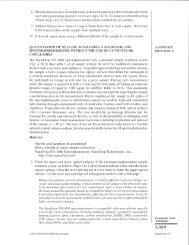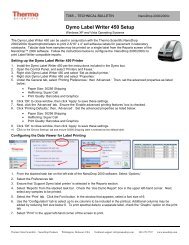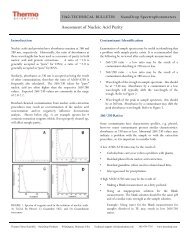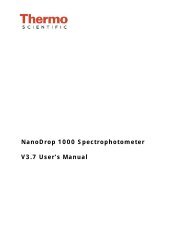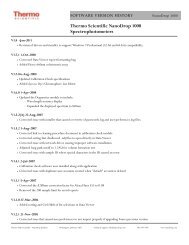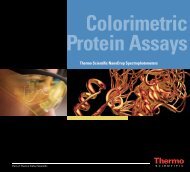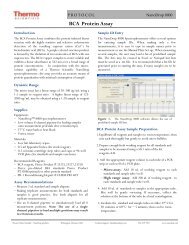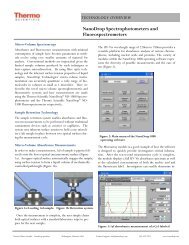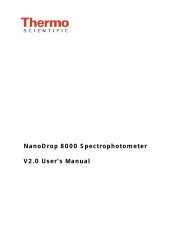NanoDrop 2000-2000c & 1000 Calibration Check procedure.pub
NanoDrop 2000-2000c & 1000 Calibration Check procedure.pub
NanoDrop 2000-2000c & 1000 Calibration Check procedure.pub
- No tags were found...
You also want an ePaper? Increase the reach of your titles
YUMPU automatically turns print PDFs into web optimized ePapers that Google loves.
INSTRUCTIONS <strong>NanoDrop</strong> <strong>2000</strong>/<strong>2000</strong>c & <strong>1000</strong><strong>Calibration</strong> <strong>Check</strong>A vial of CF-1 (aqueous potassium dichromate (K 2 Cr 2 O 7 ) solution) is required to run the calibration check <strong>procedure</strong> for theThermo Scientific <strong>NanoDrop</strong> <strong>2000</strong>/<strong>2000</strong>c and <strong>NanoDrop</strong> <strong>1000</strong> Spectrophotometers.Procedure1. Ensure the measurement pedestals are clean and that a 1ul water sample “beads” up on the lower pedestal.2. Remove any lint build-up from around the instrument solenoid by following the instructions on the back page of this document.3. Open the <strong>Calibration</strong> <strong>Check</strong> Software and follow the prompts in the Customer Guidance text box of the software.4. Enter the Target Absorbance found on the CF-1 vial as directed in the images below.5. Add 1ul of deionized water and select “Blank”.6. Before opening the ampoule of CF-1 <strong>Calibration</strong> Fluid, shake vigorously to ensure solution is thoroughly mixed. Ensure allsolution is collected in the bottom portion of the ampoule.7. Carefully break the neck of the ampoule to open the CF-1 <strong>Calibration</strong> Fluid.8. Follow the on-screen prompts in the Customer Guidance text box. Using individual 1ul samples of the CF-1 <strong>Calibration</strong><strong>Check</strong> Fluid, measure 10 replicates.9. After the 10 th measurement, the calibration check results will be displayed on-screen in the Customer Guidance text box. Ifthe instrument does not pass the calibration check using 1ul samples, immediately rerun the <strong>procedure</strong> (step 8) using 2ulsamples.10. The <strong>NanoDrop</strong> <strong>2000</strong>/<strong>2000</strong>c software will archive the results in the autosave file at C:\Documents and Settings\All Users\Documents\Thermo\<strong>NanoDrop</strong><strong>2000</strong>\AutoSave\Calib<strong>Check</strong>.11. The <strong>NanoDrop</strong> <strong>1000</strong> software will archive the results will in the <strong>NanoDrop</strong> data folder at: C:\<strong>NanoDrop</strong> Data\Calib check..12. If using the <strong>NanoDrop</strong> <strong>1000</strong> calibration check specific software downloaded from our website, the results are not automaticallyarchived and must be manually saved to retain a record.13. If recalibration is required, contact us @ 302-479-7707 or by email at nanodrop@thermofisher.com.Note The CF-1 <strong>Calibration</strong> Fluid is supplied in a single use vial. The CF-1 must be used within one hour of opening the vial.Exposure to the environment or transferring of the fluid to another container may cause a significant concentration change.<strong>NanoDrop</strong> <strong>1000</strong> <strong>Calibration</strong> <strong>Check</strong> Screen<strong>NanoDrop</strong> <strong>2000</strong>/<strong>2000</strong>c <strong>Calibration</strong> <strong>Check</strong> ScreenThermo Fisher Scientific - <strong>NanoDrop</strong> Products Wilmington, Delaware USA Technical support: info@nanodrop.com 302-479-7707 www.nanodrop.com
2INSTRUCTIONS <strong>NanoDrop</strong> <strong>2000</strong>/<strong>2000</strong>c & <strong>1000</strong>Cleaning and Reconditioning the PedestalsPedestal CleaningClean the pedestals of all <strong>NanoDrop</strong> Spectrophotometers using the following <strong>procedure</strong>:1. Apply 3-5 ul of dH 2 0 solution to the bottom pedestal.2. Lower the upper pedestal arm to form a liquid column; let it sit for approximately 2 minutes3. Wipe away the water from both the upper and lower pedestals with a clean lab wipe.Typically dH 2 0 is sufficient for removal of samples that have dried on the optical pedestals of a <strong>NanoDrop</strong> Spectrophotometer. In thecase of dried samples such as proteins, we recommend that 0.5M HCl be substituted for dH 2 O in the above <strong>procedure</strong>. After usingHCl, repeat the process with 2-3 ul of dH 2 0 to remove any residual HCl.Do not use detergents or isopropanol as cleaning agents as their use may result in the pedestals becoming unconditioned. When thepedestal becomes unconditioned sample droplets will 'flatten-out' instead of 'beading up' when applied to the bottom pedestal.Some buffer components and reagents as well as detergents may cause the pedestal surfaces to become unconditioned. We have notedthat routine use of the Bradford reagent may result in difficulty forming columns with 1 ul samples.Pedestal ReconditioningUse the instrument pedestal reconditioning kit, PR-1, as a rapid means of reconditioning the pedestals when the surface propertieshave been compromised and liquid columns break during measurement.1. Open the vial containing PR-1 and use the applicator provided in the kit to remove a pin-head sized amount of the compound.Apply a very thin, even layer of PR-1 to the surface of the upper and lower pedestals and let dry (30 secs).2. Fold a clean, dry laboratory wipe into quarters and remove the PR-1 by rubbing the surface of the upper and lower pedestals untilall compound residue is removed. Note: The appearance of black residue on the lab wipe is normal.3. Remove the excess lint around the pedestal and used canned air to clean the santoprene seal of the <strong>NanoDrop</strong> <strong>2000</strong>/<strong>2000</strong>c.4. Test the effectiveness of the re-conditioning by pipetting a 1ul sample of dH 2 O (using a calibrated 2 ul pipettor) onto the lowermeasurement pedestal.CThe figure on left shows a flat bead ofwater on an un-conditioned pedestal.The figure on the right is a1ul sample ofdH 2 O on a properly conditioned pedestalSolenoid Cleaning (<strong>NanoDrop</strong> <strong>1000</strong> only)Field experience has shown that some brands of lab wipes may shred during the cleaning process andmay which could result in a build-up of lint under the instrument solenoid . A significant build-up oflint may alter the absorbance pathlength, resulting in erroneous measurements.1. Lay the instrument on its side with the source fiber (black fiber optic cable) facing up and openthe sampling mechanism. (Refer to the image on the right)2. Using a paperclip or a small screwdriver, manually depress the solenoid plunger and spray compressedair down the solenoid plunger hole. Be sure to keep the can of compressed air upright soas not to spray the propellant into the instrument.For Technical Support, contact us at 302-479-7707 or nanodrop@thermofisher.com.Rev 2/09Thermo Fisher Scientific - <strong>NanoDrop</strong> Products Wilmington, Delaware USA Technical support: info@nanodrop.com 302-479-7707 www.nanodrop.com



